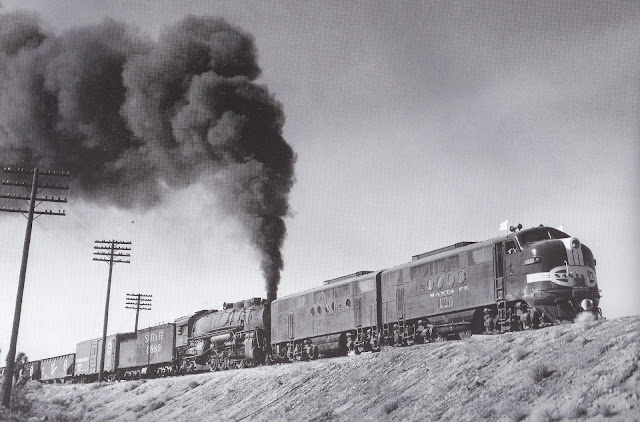Our featured locomotives this time are the Alco PA-1 and PB-1 diesels of the Union Pacific. My layout progress report will be about recruiting volunteers to help build my layout, including the first visit by one of my volunteers.
The UP acquired three PA-PB-PA sets in Sep. 1947, with leading cab numbers of 994A-997A. These were soon renumbered to 600-603 in March, 1948. Then in Jan. 1949 they acquired four PA-PB sets with leading cab numbers of 604-607.
Chard Walker shot a three-unit PA set entering Victorville through the Upper Narrows, passing the Rainbow Bridge, with an eastbound secondary passenger train in the late 1940s (beautiful):
In October, 1947, before the renumbering into the 600-series, set #997 with the eastbound Utahn was climbing near Alray, thanks to the Richard Kindig Collection:
The UP mixed their PA and PB units together as needed. Here is a PA-PB-PB set #602 passing the Victorville Lime Rock plant with a westbound passenger train in 1953, as shot by Don Sims from up on the Rainbow Bridge approach (I love this shot!):
Here we see a PA-PB-F3 set with a heavyweight train, being helped eastbound up Cajon Pass by 4-8-2 #7019, as shot by Chard Walker:
The PAs were also mixed with FM Erie-Built units, as seen here at Summit with the eastbound LA Limited in June, 1952, as shot by Robert Hale. The UP TR5 cow-calf set on the right helped the train to Summit:
Note that the PAs are always pulling secondary trains, as they were not as reliable as the EMD passenger diesels (same as on the Santa Fe).
Here we see #606 leading a three-unit PA set with a westbound Shriners Special out of Victorville, climbing at Frost, as shot by Frank Peterson in June, 1950:
Here is #605 with a mixed PA-PB-Erie set being helped eastbound up Cajon Pass by a 4-10-2, as shot by Chard Walker:
In this next shot by Richard Steinheimer, #605 is leading an A-B-A set with the westbound Utahn out of Summit in the 1950s:
Let's conclude with a classic shot by Donald Duke, showing UP 4-8-2 #7019 helping PA #605 and a mixed set of diesels with the eastbound LA Limited at Sullivan's Curve in June, 1950:
As for HO models of the UP PAs, there have been many, so I will only cover the most common styrene models here. Athearn made PA-PB models for many years, as seen here:
I think that most of my PA-PB models came from Proto 2000, as seen here:
Walthers later upgraded these and sold them as Walthers Proto:
Broadway Limited also made UP PA-PB sets:
And so did MTH:
And now for my layout progress report...
and then on the actual track plan, as you can see in the image below:



























